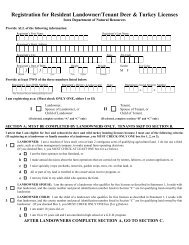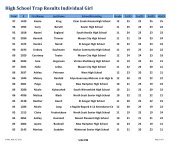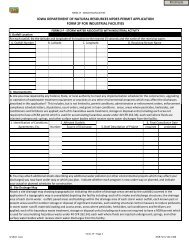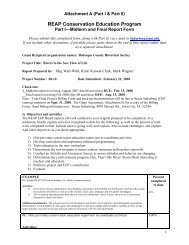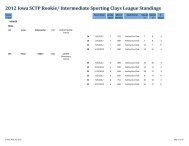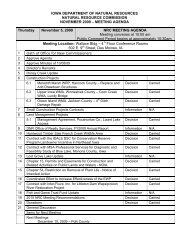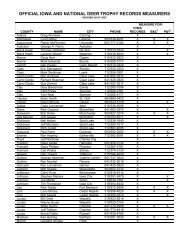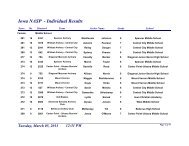Waste Reduction, Construction and Demolition Debris - Iowa ...
Waste Reduction, Construction and Demolition Debris - Iowa ...
Waste Reduction, Construction and Demolition Debris - Iowa ...
Create successful ePaper yourself
Turn your PDF publications into a flip-book with our unique Google optimized e-Paper software.
INTRODUCTION<br />
This document is intended to lay the foundation for resource reduction strategies in new construction, renovation <strong>and</strong> demolition.<br />
If you have an innovative idea or information that you believe should be included in future updates of this manual please email Shelly<br />
Codner at scodner@region12cog.org or Jan Loyson at Jan.Loyson@<strong>Iowa</strong>lifechanging.com.<br />
Throughout this manual, we use the term “waste reduction” to define waste management initiatives that will result in less waste going<br />
to the l<strong>and</strong>fill. In accordance with the waste management hierarchy these practices include reducing (waste prevention), reusing<br />
(deconstruction <strong>and</strong> salvage), recycling <strong>and</strong> renewing (making old things new again) - in that order. This manual will explain what<br />
these practices are <strong>and</strong> how to incorporate them into your projects.<br />
FIRST AND FOREMOST<br />
Follow all Federal, State <strong>and</strong> Local regulatory guidelines <strong>and</strong> compliance requirements when undertaking any construction or<br />
demolition resource reduction project. Areas of consideration should include but are not limited to the following:<br />
• Asbestos (See Appendix A)<br />
• Beneficial Reuse of Solid <strong>Waste</strong> (See Appendix B)<br />
• Hazardous Materials (See Appendix C)<br />
• Storm Water Permitting (See Appendix D)<br />
• Universal <strong>Waste</strong> (See Appendix E)<br />
The regulatory summaries that appear in the appendices above were prepared by the <strong>Iowa</strong> <strong>Waste</strong> <strong>Reduction</strong> Center/University of<br />
Northern <strong>Iowa</strong>. For a complete listing of other regulatory summaries that might be applicable to your individual project(s), please see<br />
Appendix F. You may access these regulatory summaries online at www.iwrc.org/regsums.<br />
CONSTRUCTION AND DEMOLITION WASTE DEFINED<br />
<strong>Construction</strong> <strong>and</strong> <strong>Demolition</strong> debris (C&D) is defined as all non-hazardous solid waste resulting from construction <strong>and</strong> demolition<br />
activities. C&D materials that can be reused or recycled include but are not limited to the following:<br />
• Acoustical ceiling tiles<br />
• Asphalt<br />
• Asphalt shingles<br />
• Bricks<br />
• Cardboard<br />
• Carpet <strong>and</strong> pad<br />
• Concrete<br />
• Dirt<br />
• Drywall<br />
• Field office waste (paper, cans, glass,<br />
plastic bottles <strong>and</strong> cardboard)<br />
• Fluorescent lights <strong>and</strong> ballasts<br />
• Insulation<br />
• L<strong>and</strong>clearing debris<br />
DISASTER DEBRIS – SPECIAL CONSIDERATIONS<br />
Every year, natural disasters destroy residential <strong>and</strong><br />
commercial buildings across <strong>Iowa</strong>. In a crisis, emergency<br />
management of debris places yet another burden on<br />
property owners <strong>and</strong> emergency managers. Typically, a great<br />
deal of demolition debris needs to be managed in a short<br />
period of time.<br />
All <strong>Iowa</strong>ns should be concerned with public health,<br />
safety <strong>and</strong> environmental impacts when demolition<br />
debris is mismanaged <strong>and</strong> offers assistance to communities<br />
in managing storm-generated debris. In the wake of a<br />
natural disaster please contact your IDNR field office<br />
before undertaking cleanup activities. You may access<br />
contact information for your specific field office at<br />
www.iowadnr.gov/fo/index.html.<br />
Typical types of waste generated from natural disasters are<br />
listed below.<br />
Appliances<br />
Appliances frequently contain hazardous materials such<br />
• Metals<br />
• Paint<br />
• Plastic film from packaging<br />
• Porcelain<br />
• Window glass<br />
• Wood<br />
<strong>Waste</strong> sorting activities in wake of the May 25, 2008, EF5 tornado, that touched<br />
down in Butler County <strong>Iowa</strong>. The twister destroyed one-third of the community<br />
of Parkersburg <strong>and</strong> then continued its path of destruction through rural New<br />
Hartford before heading into Black Hawk County. Less than two weeks later, the<br />
community of New Hartford was hit again as devastating flood waters engulfed<br />
the entire community.<br />
PHOTOS COURTESY OF JERRY PLATTER<br />
3



